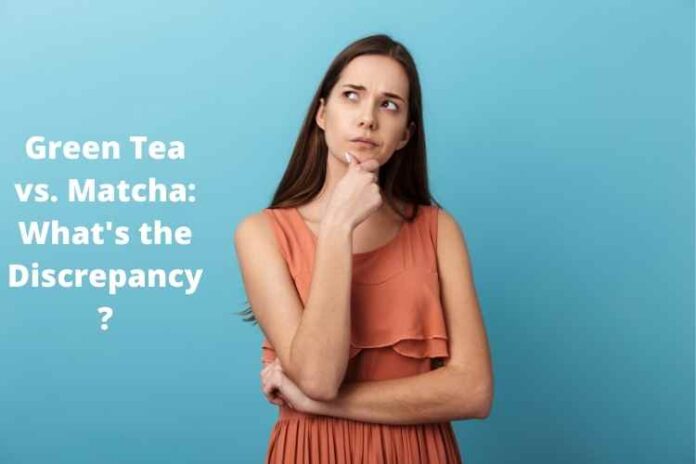In this blog we are going to tell you about Green Tea vs. Matcha. so read this blog carefully to get the complete information
The Camellia sinensis shrub is the source of both matcha green tea. Green tea is usually sold loose or in bags. Matcha is prepared with ground green tea leaves.
Each type of tea might well have different health benefits, as well as some people may favour one flavour or property over another.
What Exactly is Green Tea?
The Camellia sinensis plant makes green tea, which is one type of tea. Other forms of tea, including such black, white, & oolong tea, are made from the same plant.
Green tea is made by harvesting tea leaves & quickly heating them. This keeps the leaves from turning brown & oxidising. They may process the leaves using several ways, like boiling, pan burning, or solar drying, depending on what type of tea.
The leaves are then rolled and dried to get their final shape. The tea is made by soaking the tea leaves in hot water.
Green tea has a flavour that is earthy, grassy, or vegetable-like. The tea leaves produce a clear, yellowish green to pale brown drink when brewed. In the mouth, green tea can have a moderately tannic flavour.
Too much time in the teapot results in a dark brew that might be too bitter for some.
RELATED – WHAT ARE THE DIFFERENCES AMONG PRIME RIB & ROAST BEEF?
What Exactly is Matcha?
Matcha is a green tea variety. Matcha is made from Camellia sinensis leaves using sophisticated growing & processing procedures.
Toward the end of the harvest, they cultivate the tea shrub in the shade. This shields it from the sun and slows its growth, giving the tea leaves their particular flavour.
The leaves are immediately dried after harvesting to prevent oxidation. They then ground the leaf matter into a thin, bright green powder, removing the stems and veins.
The tea is obtained by dissolving the powder in heated water. Bamboo whisks have traditionally been used to help eliminate clumps of powder & provide the drink a consistent texture. Electric milk frothers or contemporary whisks may be used.
Matcha is a bright green tea. It may be a little frothy on top, according to the processing. The flavour of matcha is green and earthy, with sweet and savory overtones.
If the flavour is too intense for a person, almond milk or a sugar to the recipe may help to soften it.
Dissimilarities Between Green Tea and Matcha
Dissimilarities between them
Green tea and matcha are both made from the very same plant as the other teas. The biggest distinctions are in their manufacturing procedures and the final product content.
Matcha undergoes a more meticulous cultivation and extraction method than other teas. Most green teas are not grown in the shade or protected from oxidation by their manufacturers. These extra stages assist control production variables & provide matches to its distinct qualities.
During harvest, different teas will go through numerous processes including such boiling, drying, & rolling. Depending on what type of green tea, several procedures are used.
Matcha & green tea have different flavours due to the final product. Unlike green tea, which has a light, refreshing flavour, matcha has a richer, grassier flavour.
Some may regard the drink to be a robust green tea because it includes whole crushed tea leaves.
Green Tea Health Benefits
Green tea has been used for medicinal purposes for aeons in nations like China and Japan.
RELATED – CHILI POWDER VS. ANCHO CHILI POWDER: WHAT’S THE DIFFERENCE?
Some Investigation
Green tea, according to Trusted Source, contains antioxidants as well as minerals like magnesium & manganese.
Green tea as well as its constituents may have a number of advantages.
A Reliable Source
- Heightened mental acuity
- Headache alleviation better Working memory
- Weight loss assistance digestive symptom relief
Matcha’s health advantages
Matcha has many of the same advantages as green tea.
Its cultivation, harvesting, and method of preparation may increase the production of some health-promoting chemicals, making it the most abundant supply of these compounds.
These procedures have the potential to increase levels of:
- Caffeine
- THeanine
- Chlorophylls
- Antioxidant catechins
Green tea’s most effective & plentiful antioxidant, epigallocatechin-3-gallate, is found at high amounts in matcha.
Matcha may help health and quality of life because many of green tea’s advantages are derived from all these powerful antioxidants.
Matcha’s advantages could include:
Enhanced cognition & memory functioning, dcreased oxidative stress, lessened inflammation, improved metabolic health markers, reinforced blood arteries in the heart, and lowered tumour growth factors in the stomach.
Because matcha employs the entire leaf, the components in the tea may be extracted more completely.
RELATED – What’s the Difference Between Wheat Bran and Wheat Germ?
Conclusion :
We Hope this blog is sufficient enough to provide the information about Green Tea vs. Matcha. Thanks for reading this blog.


